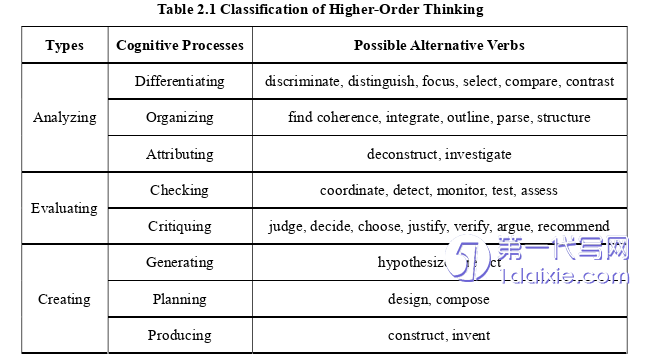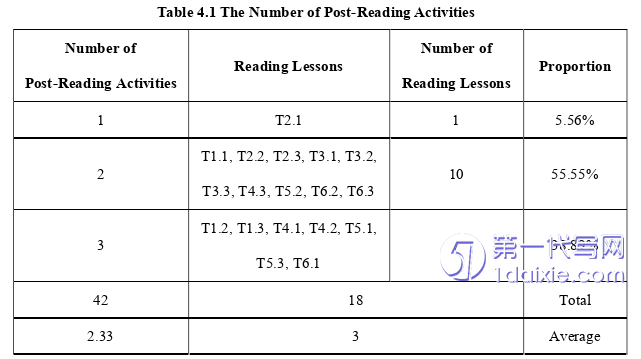本文是一篇英语论文,本研究重点关注发展学生高阶思维的高中英语阅读课读后活动的特点,从多个方面分析原因并提出相应的建议,希望能够为教师优化读后活动的设计与实施以更好地发展学生的高阶思维提供一些启示。
Chapter One Introduction
1.1 Background of the Study

With the deepening of educational reform, the newly-revised National English Curriculum Standards for General Senior High Schools (2017 Edition 2020 Revision) (hereafter NECS) was released in 2020 by Ministry of Education in China, and NECS puts higher requirements on senior high English teaching and the development of students’ thinking quality. Thinking quality is a crucial dimension of English subject core competencies and the development of thinking quality is conducive to enhancing students’ ability to analyze and solve problems, enabling students to observe and understand the world from a cross-cultural perspective and to make correct value judgments on things (Ministry of Education, 2020). Huang (2017) emphasizes that the core of education is to develop students’ thinking quality and teaching for thinking is not only essential but also feasible. It is both important and possible to cultivate and develop students’ thinking quality in English teaching.
Nowadays, thinking quality has gained increasing attention in research related to its cultivation and development. Activity plays an important role in developing students’ thinking quality (Steve, 2014; Shabana, 2015), and teachers can adopt various comprehensive practical activities to train students’ thinking quality, such as drama performances, speeches and debates, and literature appreciation (Chen, Wang, & Qian, 2019). Additionally, many scholars agree that English reading classes play a critical role in developing students’ thinking quality (Lu, 2016; Xia, 2018; Zhang, 2018; Lin & Guo, 2018; Liu, 2019). In a similar vein, Zhang and Wang (2019) state that reading text is recognized as an important medium for the cultivation of thinking quality and reading is to understand symbols and construct mental representation by means of thinking. Therefore, English reading teaching is an important way to cultivate and develop students’ thinking quality, and it is of great significance to develop students’ thinking quality in senior high English reading classes.
1.2 Purposes and Significance of the Study
English teachers are supposed to design and implement post-reading activities purposefully under the guidance of the activity-based approach to English learning, so as to promote the cultivation and development of students’ higher-order thinking in senior high English reading classes. This study aims to find out and understand the characteristics of post-reading activities used by teachers in senior high English reading classes, including the overall features of post-reading activities, i.e., the number, time, forms, and types of post-reading activities, and the thinking skills at different cognitive levels developed by these post-reading activities, and also to explore the reasons why post-reading activities have these characteristics. Therefore, this study adopted the classroom observation and interview to carry out a three-month case study on the post-reading activities implemented by six senior high English teachers in a secondary school in Chengdu, mainly answering the following three questions: (1) What are the overall features of post-reading activities implemented by teachers in senior high English reading classes? (2) What students’ thinking skills in lower-order thinking and higher-order thinking are developed by the post-reading activities used by teachers? (3) What are the reasons for the above characteristics of post-reading activities? After that, this study also tries to give some advice for teachers accordingly, hoping to provide reference for front-line teachers. What’s more, the study attempts to call on English teachers to pay attention to the importance of cultivating and developing students’ higher-order thinking with various English post-reading activities. Hopefully, the study can give some inspiration and prospects for the further studies on post-reading activities for higher-order thinking, too.
Chapter Two Literature Review
2.1 Higher-Order Thinking
2.1.1 Definition of Higher-Order Thinking
It is necessary to have a good knowledge of thinking, thinking skills, and thinking quality first for a better understanding of higher-order thinking. Thinking is generally deemed as the inner activity of human brain. Scholars hold different understandings of it. Bruner (1986) proposes that thinking is the transcendence of given information. Beyer (1991) states that thinking is a complex psychological activity, involving multi-level processing mechanism, but thinking skills are discrete psychological activities, such as classifying, predicting, judging, reasoning, and creating. Wang and Mei (2018) point out that thinking refers to a general and indirect reflection of objective things and connections.
As for thinking quality, it involves different thinking skills and can be developed with various mental or cognitive activities. According to Lin (2005), thinking quality is the personal characteristics of human thinking, which manifests individual differences in thinking level, intelligence, and ability. Lin (2017) also elaborates five features of thinking quality, including profundity, agility, flexibility, creativity and criticality. Thinking quality is the ability and level which vary according to different individuals in logicality, criticality, and creativity, etc., and it is a significant aspect of English subject core competencies. Thinking quality enables students to understand and analyze specific phenomena related to language and culture, organize and summarize information, construct new concepts of their own, analyze and infer the logic in information, make sound judgments of all kinds of ideas, and express their own views creatively, and to form the awareness of multiple thinking and cultivate the ability of creative thinking (Ministry of Education, 2020). Thinking quality plays an increasingly important role in students’ English learning.
2.2 Post-Reading Activities
2.2.1 PWP Three-Stage Reading Teaching Model
PWP teaching model involves three stages (pre-, while-, post-) in a lesson, which is student-centered and activity-based, and it has been favored by many teachers in English teaching for many years (Wang, 2011), and is applied in different types of lessons such as listening, speaking, reading, and writing classes. PWP three-stage reading teaching model is formed by applying PWP teaching model in English reading teaching and it is widely used in English reading classes (Wang, 2006; Ministry of Education, 2020). Therefore, senior high English reading class is divided into three stages under this model: the pre-reading stage, the while-reading stage, and the post-reading stage, with different activities and purposes in each stage.
According to Lu and Wang (2013), pre-reading is the preparation for reading, mainly including the activation of existing knowledge and experience, and background knowledge, the introduction of topics, the guidance of students to predict the text content, the presentation of new words in the context of topics, and the removal of the language and cultural barriers in understanding the text; while-reading is the core of reading teaching, and various reading skills are cultivated and developed at this stage. Skimming, scanning, detailed reading, and some other reading skills are employed to get to know, understand, and analyze the reading text; post-reading generally focuses on the application and synthesis of knowledge, using the information obtained from reading, perceived vocabulary and syntax to carry out productive activities such as discussion, retelling, and writing.
Chapter Three Methodology ..................................... 27
3.1 Research Questions ........................... 27
3.2 Participants ..................................... 29
3.3 Research Methods ...................... 31
Chapter Four Results and Discussion ................................... 37
4.1 Overall Features of the Implemented Post-Reading Activities ......................... 37
4.1.1 The Number of Post-Reading Activities ............................. 37
4.1.2 The Time of Post-Reading Activities ............................ 38
Chapter Five Conclusion ........................................... 58
5.1 Major Findings of the Study ....................................... 58
5.2 Pedagogical Implications of the Study ....................................... 62
5.3 Research Limitations and Future Research Directions ..................................... 63
Chapter Four Results and Discussion
4.1 Overall Features of the Implemented Post-Reading Activities
Classroom observation was carried out to discover the characteristics of post-reading activities for higher-order thinking used by teachers in senior high English reading classes. The data collected through the classroom observation sheet were analyzed with Microsoft Excel and the whole results are shown in Appendix Ⅳ Results of Classroom Observation. In the following part, the overall features of post-reading activities implemented by teachers are discussed, including the number of post-reading activities, the time of post-reading activities, the forms of post-reading activities, and the types of post-reading activities.
4.1.1 The Number of Post-Reading Activities
The six senior high English teachers were deliberately chosen as the research participants because they usually implement post-reading activities in their reading lessons. Therefore, all the reading lessons observed in this study cover one post-reading activity or more, and the specific number of post-reading activities in each reading lesson can be seen in the following Table 4.1.

Chapter Five Conclusion
5.1 Major Findings of the Study
The study centers on researching on the characteristics of post-reading activities for higher-order thinking employed by English teachers in the actual senior high English reading classes including the overall features of post-reading activities such as the number, time, forms and types of post-reading activities, and students’ thinking skills at different cognitive levels developed by these post-reading activities, and exploring the reasons why post-reading activities for higher-order thinking have the above characteristics from different aspects. Therefore, the study carried out a three-month case study on the post-reading activities for higher-order thinking implemented by six senior high English teachers in reading classes from the perspective of the activity-based approach to English learning through classroom observation and interview in a suburban public secondary school in Chengdu.
18 reading lessons of six senior high English teachers were observed and recorded with the help of the classroom observation sheet and the results of classroom observation reveal that post-reading activities for higher-order thinking in real senior high English reading teaching have the following two characteristics.
Firstly, on the whole, enough post-reading activities are carried out in most senior English reading classes in terms of the number of post-reading activities and most post-reading activities are implemented appropriately and completely in terms of the implementing time. Thus, students have adequate time to participate in lots of post-reading activities to develop their different thinking skills. Nevertheless, some post-reading activities are finished in a rush or cannot be accomplished in class because teachers spend too much time on pre-reading and while-reading stages or on other post-reading activities. Therefore, teachers should pay more attention to their time arrangement or time management of different reading stages and activities. Besides, the post-reading activities implemented are of various forms and types and are employed to achieve different purposes.
reference(omitted)
